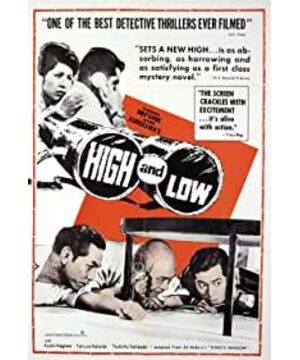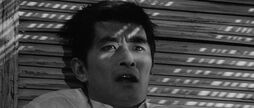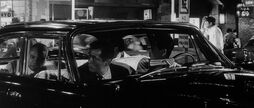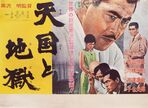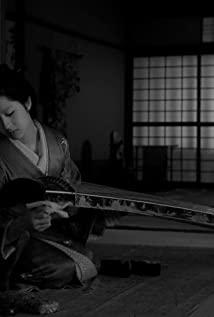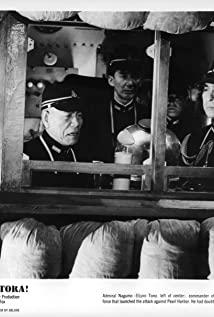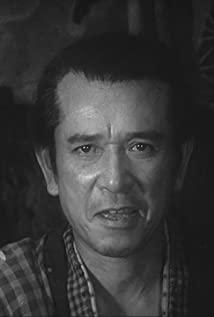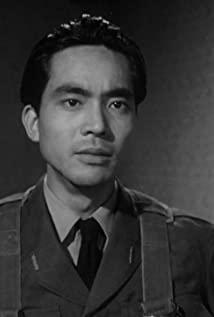From the beginning of the film, the scenes that appear in turn are high-rise buildings, factory areas, and poor streets. They have the same scene and duration. Yes, the film does not solve problems, it only raises problems. Perhaps it is the director's foreshadowing of the whole film, that every class of people is equal, and the class itself is not equal, and the right and wrong among them should not be borne and resolved by people. This is a black-and-white film. For the audience watching now, the grainy black-and-white film is more suitable for telling society and history. The story is endowed with a calm temperament, matched with objective lenses and real life.
In nearly one-half of the entire film, the camera did not move out of Nakayo's home, and most of the time it was concentrated in the living room. Audiences mostly regard movies as consumer goods for the purpose of entertainment, and direct sensory stimulation is the guarantee of the box office. In the 1960s, Japan was in a period of social transformation. People's work pace accelerated, and there were few options for leisure. Watching movies was a pastime. The first 54 minutes of this film is bound to tire the audience out. They wanted to spend money on fun mirrors, but the director gave a flat mirror, even if it was polished. I didn't test the director's original intention, maybe he wanted to integrate the characteristics of the East in the aesthetics of the film. The film is an invention of the West, and the East is mainly imitation. In Hollywood in the 1960s, movies gradually became genre films, with special effects and fast-color editing flooding the screen. First of all, following the trend is the small family spirit of all living beings, and following the feeling is the great wisdom of the master. Secondly, both from an aesthetic and philosophical point of view, the East and the West are not different from each other, but they are not like-minded. You take your Yangguan Road, and I cross my single-plank bridge. It is not a bad idea that the well water does not make the river water. The West is sensual and intense, and the East is imagery and restrained. We should make our own films. And Japan has made great achievements in continuing traditional culture and Japanese people's step-by-step character, which is conducive to Kurosawa to make a rigorous and implicit film. From an artistic point of view, as far as I feel, these 54 minutes were stagnant waters, densely covered with organs, and micro-characters were drawn into the wood.
First, analyze the 54 minutes in form. Kurosawa has the patience to shoot, and I have the patience to believe his evil. At the beginning of the film, Mr. Nakadai pulls the curtains, the outside is bright, and the inside is dark, symbolizing that the world is bright, and there are always places and people in the dark. After watching the whole film, I thought that the action of "drawing the curtains" itself is meaningful, and that only one can bring light to the world. This is Nakadai. In the backlight, the light is involved in character shaping, and he is also a cold-blooded businessman. In the subsequent conversation, when the camera turned to Nakadai, a pile of high heels appeared at the forefront, and they took up one-third of the picture, implying that Nakadai is not so much a person, but a person who regards his career as his life, and high heels The shapes are sharp and piled up indiscriminately, which also sets off a tense atmosphere. The lower body of the assistant after the middle generation takes up a quarter of the shot, explaining his status and character relationship. This shot, which will be mentioned later, was captured on my second viewing. Ordinary audiences do not report the psychology of analysis and deconstruction. They watch rather than watch and observe. They often don't notice it, and they won't be far-fetched. But the following phenomenon, which I noticed when I watched it for the first time, also made me interested in the structure, form and 54 minutes of this film. I call it a triangle for short.
The triangular structure is the so-called strongest. No wonder the triangular relationship is constantly being rationalized and chaotic. And in architectural design, it is definitely useful. List the triangular lenses first. The first one is three directors sitting on the sofa weighing a row, he is facing them in front and facing away from the camera to become the vertices of an isosceles triangle. At this point their conversation is normal. And they also embraced him, and he became a strong man on his own. The second triangle is when the directors discuss the stock, they form an oblique triangle, which is visually unbalanced and the conversation begins to diverge. The third triangle is when Zhongdai talks on the phone, he is facing the camera in front of his wife and assistant, and he learns the progress from the phone. The fourth triangle is Nakadai drinking to celebrate, he is facing the camera behind his wife and assistant. In the third and fourth, Zhongdai is approaching success and joy step by step. He is strong and has always been at the top. And in the fourth, he told his wife and assistants the news, and they moved from behind him to him. The fifth triangle is the child Nakadai, the assistant and the detective who are listening to the recording. The three of them have their own influence on the incident and occupy three vertices, while the child's father, the driver, is outside the triangle, showing his powerlessness. To find a social class that fits the theme, the focus here is to discuss the difference between classes rather than how bad they are. Roughly use a triangle to draw a clear boundary between inside and outside, regardless of the difference between high and low, but some are so low that they have no place. The driver is the father of the client, but he is like an outsider who has lost his human rights because of social deprivation. At the same time, Zhongdai was still the apex, but went back and forth between the assistant and the detective, which not only reflected his inner hesitation, but also implied the two opinions represented by the detective and the assistant. The sixth triangle is the driver, the detective, and the middle generation. They sit, squat, and stand respectively, which is exactly the difference between their class and power.
The above lens and analysis may be my whimsy. The only certainty is that nothing is still in the world, everything is in motion. From notes to analysis to conclusion, boredom turns out to be the pleasure of dozing off. The director uses triangles to introduce the relationship between characters and promote the development of the story, and the shape of the triangle itself is also a kind of language. Its straight sides and corners are not smooth and sharp, which sets off the tension and contradiction in this paragraph. Human feelings are the same. What the eyes feel must be passed on to the heart. If the triangle is established, Akira Kurosawa spends a lot of time in a scene, whether it is to provide a background for his experiments. Unfortunately, no matter whether it is true or false, the audience perceives it subtly, but if no one tells it, it reflects the effect but also loses its effect.
However, Akira Kurosawa chose a popular story as the subject matter. Perhaps the structural aesthetics and formal aesthetics in this film are to serve ingeniously in genre films.
For the first 54 minutes, the curtains lifted lightly. As the above video starts the meaning of the curtains. When the driver, assistant, and wife pleaded with Zhongdai respectively, the curtains all played the same role. Zhongdai lingered against the curtain, his body dragged the curtain, and they followed Zhongdai back and forth. The tug-of-war between people is displayed in the form of curtains.
There are also two interesting shots, both related to the assistant, both tending to his subjective point of view. One is when the directors are discussing, the assistant is at the front of the camera, but with his back to the camera, he is standing and they are sitting. And his role in the company is also easy to ignore and cannot be ignored. Another is that the assistant changed his mind to save Jingyi, and he stood outside the door. For the first time, Nakadai and his assistant in the shot are separated by an obstacle.
In addition to these 54 minutes, more than half of the time is left, but due to the increase of plots and situations, it seems that the first paragraph is too procrastinated, and the second paragraph is too sloppy. Even the roles have suddenly increased. The style seems inconsistent. The rush in the latter paragraph may be related to the story itself. The director tried to make the chase fast and tight, but I saw it was more complicated and complicated. For example, the two scenes of the police department's internal meeting and the press conference were too carefully filmed. People watch the detection in the movie focusing on the feeling of being there, rather than grasping various clues like watching Agatha and finding the answer before the end. It is also not ruled out that Kurosawa's salute to the police is due. This is something.
The latter paragraph is like a hodgepodge of what you want, and the slightly frivolous temperament is the epitome of Japanese society. In the passage where the police follow the doctor, the Japanese style is shown through the street scene. For example, the signs of shops are written in English, and cafes and jazz music abound. In the bar, blacks and whites were mixed, and they were buying wine with gestures. Japan is in Asia, but not on the Asian continent. Imported culture and importedism have gradually become one of the characteristics of Japanese art itself. But in the hands of Akira Kurosawa, who promotes Japanese traditions, foreigners have a place in the camera when they are filming criminal transactions and people indulging in sensuality. His position is clear.
The highs and lows of heaven and hell are expressed through the occupation and social status of the characters. If society is a hodgepodge, some people are the bottom line, some are meat and bones, and some are condiments. Led by Zhongdai are merchants who have gone from developing to developed stage. Occupationally, he controls most of the means of production, exploiting the surplus value of workers for profit. From a personal point of view, Zhong Dai worked hard for his career and ideals, self-reliant and resourceful. But reaching this level was by no means the result of one person. Zhongdai also made his fortune on his wife's dowry. And some of the businessmen are assistants, they are the most directly exploited people who give advice on how to exploit the boss. This can explain the reason why the assistant and Nakadai turned against each other in the film. The assistant is a chess piece to be played with by the directors. They use him to help the world, but he just wants to be on his own. Looking at the policemen in the film again, I wonder if Kurosawa Akira deliberately beautifies them. Their images are complete servants. It can be seen from their harsh working environment and responsible working attitude that their motivation to solve the case comes from helping Zhongdai Geng. can be seen. They are not like spokesmen for the government and the law. Out of sympathy for Zhong Dai, they did not arrest the doctor in time for the case, but gave him a new trap. The doctor did not have the most suitable identity for cynicism. He struggled from the bottom to the middle class and gradually entered the mainstream society. However, from the director's point of view, it is precisely such a role in the collision and integration of classes is needed that there is subjective motivation and objective conditions to resist. At the bottom are drug addicts. From the naive details of their words, it can be seen that this is an uneducated group, and their thoughts and thinking must not be much or deep. And they live in the midst of being drunk and dreaming and eating the last meal but not the next, and it is unlikely that they will think about some metaphysical issues that cannot be eaten as food. In the camera, no class is completely good or bad. What they do is in line with the principles and interests of their class, but in practice they make compromises and concessions. People are small screws on the wheel of society. Everyone works hard for themselves, but it is society that moves forward.
The final shot of the film also reflects the run-in of classes. Nakadai and the doctor, one is outside and the other is inside, but there is no difference in the camera. What I saw were the two of them reflecting each other across the barbed wire and the glass. The clear self and the blurred counterpart appear together in one shot. In the director's view, class will not disappear.
View more about High and Low reviews


